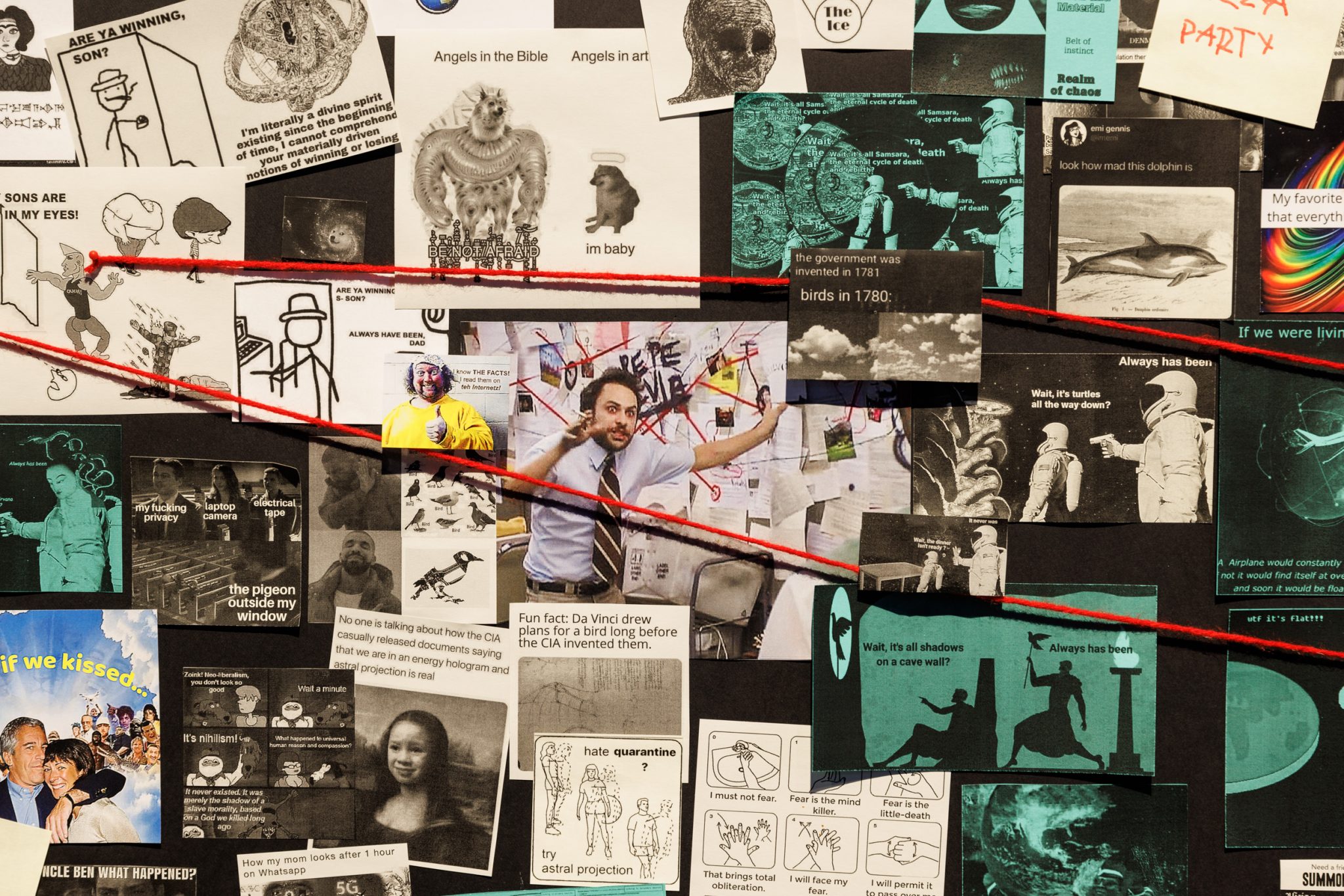A new show at KW Institute, Berlin examines the role of digital technologies today and their implications for knowledge, power and liberation
Featuring works by more than 40 artists across all four floors of KW, Poetics of Encryption is a vast, frequently overwhelming exhibition. It’s also part of a larger rollout: the eponymous 2023 book by the show’s curator, Nadim Samman, a website with three online commissions and a conference. Together these examine the role of digital technologies today and their implications for knowledge, power and liberation. The show is divided into three chapters: Black Site, Black Hole and Black Box. We begin, appropriately, in near darkness, walking unsurely through the ground floor’s chamberlike rooms. In Roger Hiorns’s Film Footage of ‘A Retrospective View of the Pathway’ Ipswich Burial (2016–) a military plane is interred deep in the ground; in Sebastian Schmieg’s Search by image, recursively, starting with a transparent png (400 × 225px), 2951 images, 12fps, 2011 (2011–) a transparent PNG with no visual information is run through Google’s ‘search by image’ function. Quickly it mutates into other, ever more outlandish images, their associative links obscure. The sense, upfront, is of being buried and overwhelmed.
Can algorithms access hidden knowledge? In short, yes: if only in terms of scale, they are privy to knowledge that will always exceed the human. Poetics of Encryption focuses on and narrates this condition. In one elaborate representation of unknowing, Nico Vascellari’s videowork Vit (2020) – here projected to terrifying, epic proportions – the artist is sedated before being hoisted by a helicopter, his inert body dangling over a sublime Italian mountain landscape. What’s the alternative to passivity? One approach is to attempt an escape and visualise the fugitive ‘real’ and the actors determining it. For Kate Crawford and Vladan Joler, that means tracking links between power, technology and control across two huge, labyrinthine wall-based flowcharts (Calculating Empires, 2023). This diagnostic instinct reappears with Clusterduck’s The Detective Wall (2020–24), a cartographic account of contemporary memes. While Crawford and Joler’s work is more serious and academic, both exemplify a paranoid impulse to make sense of an increasingly complex and inhuman world.

As a darkening, occluding force, contemporary technologies are increasingly in tension with the Enlightenment ideal of knowledge as a liberatory force and, with it, of progress. In what writer James Bridle has termed the New Dark Age, there is simply too much data – mostly illegible, at least to those navigating it. Yet this data is the bedrock of machine intelligence, which, with AI, has a growing capacity for autogenesis. In Oliver Laric’s animation Exoskeleton (2022), biological forms amass, fall apart, reform: nothing dies but rather disintegrates and reappears ad infinitum, mirroring the entropic drift of digital life. Joshua Citarella’s e-deologies (2020–23), strange colourful flags representing real, albeit fringe, political movements (‘Anarcho-Collectivist Islamo’, for example), suggest a kind of SEO-optimised politics, like threads of words meant only for machine eyes. In their chaos, they neatly convey the power of digital media – or rather, those who shape and control it – to generate misinformation and fracture contemporary political life.
This disruptive effect takes a comical turn in sculptures by Eva and Franco Mattes. Based on digital photography glitches, a pair of taxidermy cats (Panorama Cat, 2022, and Half Cat, 2020) – their bodies respectively stretched and squashed – convey the problem of applying machine learning to reality. In their wall-based Abuse Standards Violations 3 (2016–21), we see examples of visual material censored by social-media platforms. Leaked to the artists by moderators who usually do not even know their employer’s identity, the images grasp the crude logic that determines what cannot be seen. Jon Rafman’s 2023 video installation Videocabin II (You, The World, and I) transposes the myth of Orpheus and Eurydice to the story of a lover’s sole image lost during a technological update. Throughout these works, digital translation of the real is invariably accompanied by distortion or omission, and a negotiation of loss. In Jonna Kina’s Secret Words and Related Stories (2013–16), teenagers read aloud anonymously collected passwords and the stories behind them. There is poetry in this, and a reminder: while we are increasingly tethered to and determined by systems and algorithms we can neither trace nor fully understand, they are not unknowable. That’s true also of the actors creating and controlling them. If entities such as Google function like ‘black holes’, as Vladan Joler claims here in his short video New Extractivism (2020), then they are entirely manmade ones.
In Plato’s famous allegory of the cave, referenced repeatedly here and in Samman’s book, the inhabitants never see reality, only its shadows moving across the cave walls. So too with contemporary digital life; our navigation is conditional on a studied, often enforced unseeing. Poetics of Encryption, in the main, doesn’t really attempt to undo this, to illuminate or bridge gaps in knowledge. Impressionistic and, indeed, poetic rather than prescriptive, it shows instead how contemporary vision is being restricted and ruptured, in the hope of seeing in other ways.
Poetics of Encryption at KW Institute for Contemporary Art, Berlin, through 26 May
